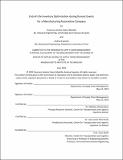End-of-Life Inventory Optimization during Runout Events for a Manufacturing Automotive Company
Author(s)
Calero Mantilla, Francisco Andres; Esposito, Andrea
DownloadEnd of Life Inventory Optimizationduring Runout Events for a Manufacturing Automotive Company.pdf (959.9Kb)
Metadata
Show full item recordAbstract
Effective and efficient inventory management is today more crucial than ever. Three factors drive its importance: (i) the ever-increasing complexity of bills of materials, causing firms to dedicate a large part of their spending to their supply base; (ii) unprecedented uncertainty, making inventory indispensable for business survival; and (iii) an emerging inflationary economy, which multiplies the cost of holding inventory. One of the most critical inventory management processes is the runout phase, which refers to stock depletion as products approach their end of life. Operational excellence during the runout phase is particularly important not only due to the negative externalities of holding excessive stock but also to the costly risk of scrapping the remaining inventory if materials become obsolete. In this capstone project, we propose an end-to-end approach to improve runout inventory management. This approach aims to guide companies in defining the problem of runout inventory management, preparing the raw data, choosing the right models, setting up the analysis, and interpreting its results. We illustrate each step of our approach by using a real-world case study from a large automotive manufacturer. Using historical data from one of their largest factories in the United States, we trained and tested several predictive models to estimate the demand during the last month of the lifecycle of materials three months in advance, when the last replenishment orders are issued. Based on our analysis, we provide several recommendations to successfully improve the company’s demand forecasting and runout inventory management processes.
Date issued
2023-09-08Keywords
Supply Chain Management, Inventory